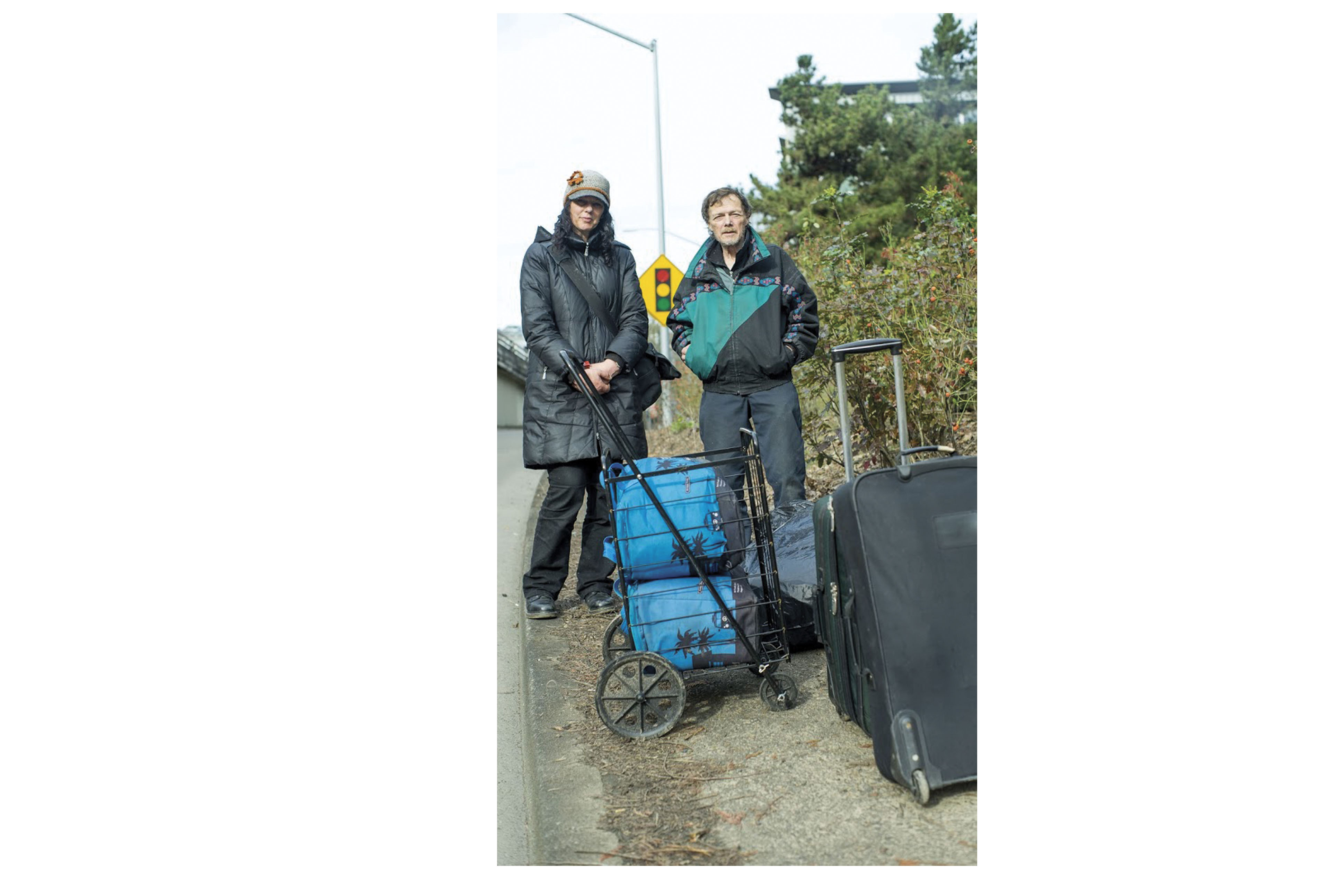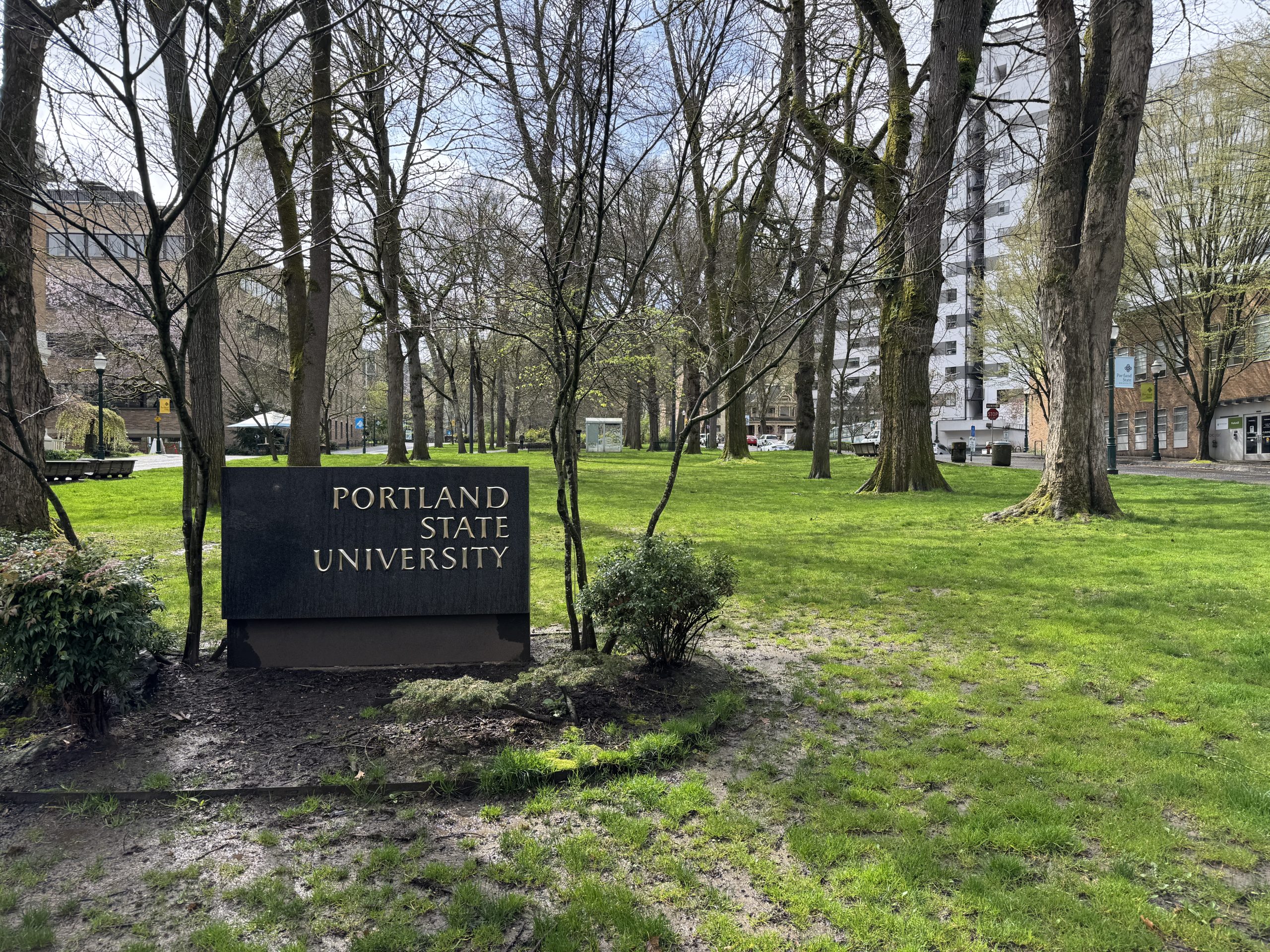Just across from the Twelfth street exit near Portland State University’s Stott Center, Ralph Hoyt and his friend Bonnie Snell organized a montage of mismatched luggage and pushcarts by the side of the road. The luggage was made for an airport–the kind with the small shifting wheels good for carpet and linoleum, not for gravel on the side of the highway where they stood.
Hoyt and Snell appeared confused and agitated. They had just been kicked out from underneath the overpass, which for the last few weeks had been home. The two didn’t have to talk with each other about their situation; they both understood they didn’t know where to go, or how they would get there. For them, this was a typical Monday.
Snell is still new to this life and struggling with her situation. This is the first time she has lived on the street. For the last five months she has had to cope with conditions that have left her feeling demoralized and humiliated. Not being able to bathe is one of the most difficult parts of her new life. Even when Snell can find a shower she is allowed to use, she doesn’t have clean clothes to change into when she’s done.
For Hoyt, the hardest part of being homeless is the lack of security that comes with being in his situation. The other part he struggles with is the uncertainty.
“I have been deemed with a disability, and I can’t get any housing,” Hoyt said.
Unlike some of the homeless in Portland, Hoyt has an income. He receives assistance resulting from a back injury that left him disabled, but the amount of money he receives each month is not adequate to secure him a permanent residence. Hoyt lives under door stoops and overpasses each night, just like an estimated 2,000 homeless in Portland that can’t find room in shelters.
Some nights Hoyt is forced to hop from one spot to another, regardless of weather conditions or his back injury. The doctor Hoyt sees a couple of times per week is the biggest reason he doesn’t move away.
Living on the streets of Portland for going on two years, Hoyt doesn’t see an end in sight.
“If you go to some of the shelters you end up getting creatures like bedbugs [and] scabies, that kind of thing,” Hoyt said. “It’s happened to me three different times.”
The scope
PSU is located in a metropolitan area that may see demographic changes as Portland’s mayor, Charlie Hales, moves forward with a $30 million plan to address the city’s homelessness crisis.
His plan will incorporate the use of city-owned spaces, such as parking garages and other publicly owned areas that could be utilized as makeshift camping areas for Portland’s homeless.
Mayor Hales’ new guidelines about where homeless individuals can sleep in the city have some Portlanders concerned about safety issues. Others support his action of declaring a state of emergency — giving him the ability to make decisions unilaterally to deal with one of Portland’s most persistent issues — as a needed action. Many believe it is a step in the right direction.
Homelessness is not an issue isolated to urban areas. At PSU, homelessness is a reality that many face on a daily basis. With some students on the brink of financial disaster and tent communities encroaching on campus, students, faculty, and administrators alike are becoming more aware of the larger issues affecting the city as they manifest on campus.
The challenges of monitoring blurred boundaries
The Campus Public Safety Office is closely monitoring increasing needs to address challenges associated with homelessness. According to Craig Whitten, lieutenant of operations, an increase of homeless activity near sections of campus is evident. Areas near Oregon Department of Transportation property bordering the west side of campus are areas of concern for CPSO.
But Whitten feels the situation is under control at this point, and he does not foresee any large scale issues arising in the near future.
“Personally, it is a concern,” Whitten said. “It’s people out there that are trying to survive and there aren’t resources available provided by the city or state to be able to do so. Here at the university we have problems trying to provide for our students.”
Officer Whitten pointed out that between SW 12th, Market, and Montgomery there are often times groups of homeless camping on either ODOT property or city property. Because the areas in question are not on school property, CPSO can only observe activities that are taking place.
On occasion, CPSO may call Portland Police Bureau to handle a situation just off of campus. Sometimes, a member of the homeless community may need medical assistance.
“We are always worried about being able to provide people with assistance, that’s our main thing,” Whitten said. “If someone needs assistance we try to locate assistance for them.”
Working to keep PSU campus gleaming for the last 11 years, Suzen Wilson and her landscape crew have plenty of stories that may make some cringe. If you can dream it she has probably seen it during her time at PSU keeping the bushes on campus at bay.
“Right now there is a mattress behind Hoffman Hall we haven’t picked up; we will,” Wilson said. “I’m surprised we haven’t [gotten] a work order for it yet. Generally that is what happens when the campus police find a camp on campus.”
Because she would see them every day, Wilson can remember a time when dealing with homeless people resulted in the development of ongoing relationships.
“Its different now,” Wilson said. “Now there is just more and more people camping and we don’t have a special way of dealing with them except through CPSO usually. If there’s people actually present on campus, then CPSO has to get them to leave.”
Wilson spends a lot more time these days doing what she calls security pruning. Security pruning is when she trims the vegetation to the point people have a hard time hiding behind them. At night this practice becomes important to maintain a safe environment for students and staff.
Wilson said that students should be aware of their surroundings in case of any dangerous situations. She cautioned against approaching unfamiliar camps alone, but she also pointed out that most in camps posed no threat.
“A lot of these people are harmless and they’re just doing what they have to do to live,” Wilson said. “But, you can’t tell for sure.”
The helpers
Each day a line begins forming in front of PSU’s student-run Food Pantry about a half hour before the door opens. Liddy Champion, Food Pantry Coordinator, arrived just before opening on Monday, Feb. 22. By then about 40 students were waiting in a line that stretched the length of the hall. This sight is not an uncommon scene each day of the week between 12:30 – 2:30 p.m.
Some days the line reaches all the way around the corner, forcing students entering the building at the top of the stairs to zigzag through the masses waiting to get food. The eclectic mixture of students ranges from young and old, foreign-exchange students and prototypical Portlanders.
For two hours a day, the Food Pantry serves an average of 100 students.
In Room 325 of Smith Memorial Student Union, a room that used to be a broom closet, Champion and her team used to see about a dozen students pass through the pantry daily. That number is growing, and as it grows, so does Champion’s concern. She worries that the increase of students using the pantry might translate outside of the pantry.
Champion thinks word is getting out about the pantry, and as that is the whole idea, she also thinks Portland’s difficult housing market is a large factor in the increase in student need. On particularly busy days, the number of students utilizing the Food Pantry climbs to 150.
The Food Pantry does not ask personal questions as students pass through the checkout line, but Champion knows some who use the pantry are dealing with homelessness, or have in the past. She knows this because some students have communicated with her.
Champion understands a little better than some what being a student in need is all about. Before she was managing the Food Pantry, or studying for biology and psychology as a double major, or working as the Associated Students of PSU senate chair, she was also a student in need.
“I feel like on an individual level there are a lot of people interested in supporting students,” Champion said. “I think on a greater institutional level it is a harder question to answer. I also think PSU and its students face a problem in that the university is so large and is in so many different spaces. It is sort of disjointed at times.”
The students
Amanda Downing makes sure to get to the student food pantry a little early. After eight terms at PSU, she is ready to wrap up her degree and move on to the next stage of her life. She studies environmental science and thinks math is easier than biology. Downing also understands the difficulty of having enough food to make it through a month.
“I’m just trying to get through school, and I don’t have the money to go out and buy a bunch of groceries when I need food to keep my brain going,” Downing said.
Twice a week she visits the Food Pantry, and between what she is able to bring home and with a little planning, she saves close to $100 per month. The money she saves enables her to maintain a delicate balancing act that keeps her moving forward.
Originally from Salem, Downing lived in Portland for 10 years before she was finally priced out and moved to Beaverton. Her rent went from $500 per month to $1,200 the next.
Downing has managed her situation while maintaining going to school, having a place to live and keeping food in the fridge. For some students the pressures are different, and in the worst case a student can end up homeless and hungry.
The response
When the the situation gets to be too overwhelming for a student to deal with on their own, PSU does have people to talk to. Located in the the office of the Dean of Student Life, the CARE Team is able to work with students on finding solutions to some of the complications they face.
Adam Jones is a graduate student intern that is available to help students dealing with housing insecurity. He started working with the CARE Team in the beginning of fall term. Since his start, Jones recalls working with about 12 students in each of those terms. He knows that some students on campus are having a difficult time. Last term, a few of the students he worked with had to withdraw due to their situation.
“Housing insecurity looks different than your typical homeless person living on the street,” Jones said.
Crashing on a buddy’s couch, bouncing from hotel to hostel, or sleeping in the lobby of Neuberger are the kinds of signs that a student is in a critical situation. When he makes contact with such students one of the first things he will do is ascertain what kind of networks the student already has. For example, Jones will assess whether or not the student has a family member that is willing to help out.
For Jones there is no silver bullet to solve the issue of student homelessness. And unfortunately, the amount of services on campus are limited.
“There’s not a lot,” Jones said. “We don’t have emergency housing here on campus.”
The rising tide of homelessness is affecting life in Portland in a profound way and solutions are complicated. The issues surrounding homelessness are just as complicated as homelessness itself.
Maybe Jones said it best, “Unless there is a radical social change, I’m not sure of what the solution is going to be.”






